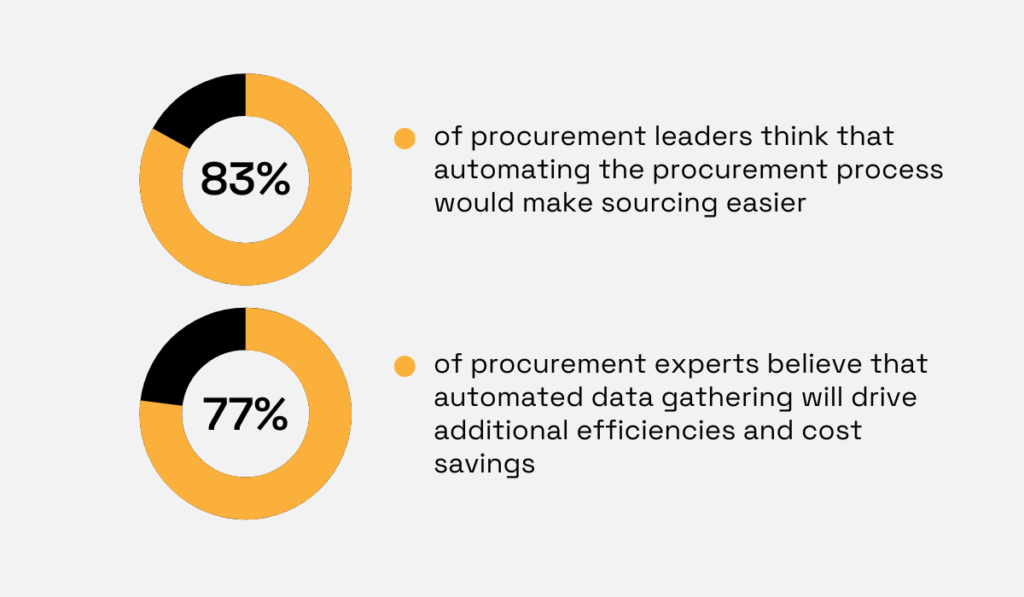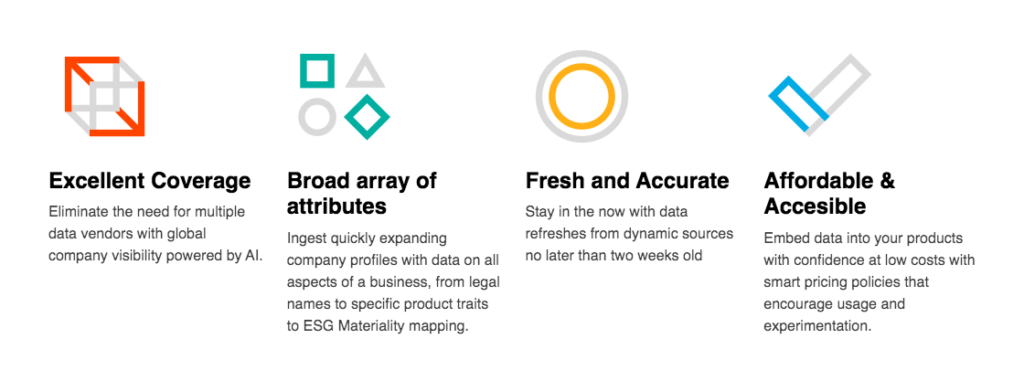Making Procurement More Data Driven: 5 Questions to Ask Yourself


Embracing data driven procurement is inevitable in the contemporary business landscape, where insights from data serve as the linchpin for strategic decision-making.
To excel as a data driven leader, you need to focus on five key questions that will help unlock the hidden potential of the procurement processes.
It all comes down to defining your procurement goals, determining what kind of data you need to reach those goals, how to collect it, secure it against external threats, and, finally, how to leverage it.
With this article, we’ll help you ask the right questions, and provide a foundation for your journey to data driven excellence.
To be able to make the right decisions for their organization, procurement departments must have a set of clear goals and solid business acumen.
So, before you step into the realm of big data, you have to ask yourself what exactly you are trying to achieve and how data is going to help you in the process.
Let’s go through some basics.
Above all, to ensure that the procurement department’s goals are aligned with the company’s overall objectives, you need to dive into past data and analytics to assess your company’s current status and business performance.
Understanding your company’s strengths and weaknesses will help you define specific procurement goals that resonate with your company’s broader vision.
Further on, it’s quite clear that every procurement executive strives to cut costs.
And that’s probably one of your primary goals, too—to reduce costs strategically while enhancing operational efficiency.
This procurement goal is all about having access to relevant and focused data that will help you identify cost-saving opportunities without compromising the quality of the products and services procured.
But the procurement role is much more than that.
It aims to achieve a balanced approach that maximizes value for the organization.
Thus, another important objective that always finds its way to the list is the ability to better monitor supplier performance.
This involves monitoring and analyzing the reliability and quality of your company’s suppliers.
But, to ensure consistent and accurate insights, it’s crucial to uphold high data quality standards.
And this means evaluating supplier performance using various metrics and leveraging data management tools to improve these metrics.
Think of it as an ongoing quality check to ensure your procurement process is running at its best.
Other than that, you may find it essential to prioritize reducing the procurement cycle time or enhancing your risk mitigation strategy.
The image below sums up some of the leading procurement goals that drive its success:

Source: Veridion
In addition, with contemporary business trends emphasizing sustainability, procurement leaders are stepping up their game to align future goals accordingly.
Essentially, the success of the procurement function depends heavily on key data insights.
Nevertheless, procurement specialists often dedicate a significant amount of time to collecting data from numerous sources simply because it goes with the territory.
This process not only consumes time and resources but, ultimately, may not even yield the desired outcome.
A more effective strategy involves approaching data collection with clear end goals in mind.
This way, you can efficiently identify and gather the specific data you need from the best sources available and use it to improve your procurement process.
Once you’ve established your procurement goals, you should focus on determining what kind of data you need to collect to be able to effectively guide procurement strategies.
By focusing on collecting the right data that is aligned with your predefined goals, you can ensure that your decision-making process will be well-informed and attuned to your overarching objectives.
The best way to capture relevant and goal-specific data and leverage it is to turn toward implementing digital procurement solutions.
Besides many other advantages, these solutions can organize and transform unstructured scattered data into useful and accurate datasets that can be readily applied to your organization’s value chain.
In other words, with a solid data foundation, the procurement function will envision better analytics and recommendations with less repetitive time-consuming tasks.
Hence, the data collection process can be structured into four main categories, as shown below:

Source: Veridion
In essence, by leveraging data in such a focused way, you can gain new competitive advantages, which will enable you to better understand and act on uncommon situations such as:
The exciting part is that you get to leverage data-backed predictive analytics, drawing insights from your company’s purchasing patterns, supplier details, and market conditions.
This enables you to spot trends and foresee changes in advance.
Next, by utilizing predictive analytics and combining it with historical patterns and current trends, you can power your future planning and optimize decision-making.
Predictive analysis helps pinpoint the most relevant factors for forecasting future outcomes, offering a strategic edge in your decision-making processes.
The bottom line is—the future of procurement is data driven.
The sooner you begin digitally capturing data that is relevant and specific to your goals, the sooner you can put it to work to resolve some of the most pressing issues, elevating the overall success of the procurement function.
The opportunity to bundle relevant information together for easy access has prompted companies to gradually shift to electronic records and databases.
Savvy companies, meanwhile, have learned early that collecting data with the help of digital procurement solutions is a streamlined approach that makes managing and retrieving important details a breeze.
In other words, you’ll collect the necessary information by using procurement automation tools.
You see, manually searching and handling supplier data requires a lot of time and staffing.
In fact, many procurement leaders agree that manual processes are inefficient, limiting their ability to gain insights into supplier data and sourcing.
According to a recent survey by Globality, 83% of these leaders think that automating the procurement process would make sourcing easier, while 77% believe it would drive additional efficiencies and cost savings.

Illustration: Veridion / Data: Globality
Automated procurement solutions minimize the manual labor and inefficiency of data gathering, helping you find more suppliers in a shorter time frame and build a cohesive supplier database.
Some of these tools offer an end-to-end solution—from collecting data to creating procurement insights.
One of such tools is our own – Veridion.
We developed an AI-powered procurement solution that’s revolutionizing supplier data gathering.
Veridion provides procurement executives access to a dynamic and constantly updated global supplier database, addressing the critical challenge of outdated data in procurement.

Source: Veridion
Our procurement solution can empower you to expedite supplier sourcing by harnessing the potency of our company search service.

Source: Veridion
Through this single advanced mechanism, you can tap into a database of over 80 million companies worldwide, which makes finding the ideal supplier easier than ever.
Moreover, our tool offers analysis, and with it plays a crucial role in mitigating supplier risks.
Namely, the system actively analyzes extensive datasets, revealing patterns and trends that indicate potential issues, like supply chain disruptions or fraudulent activities.
With these insights, you can proactively tackle the identified risks, ensuring the smooth continuity of the supply chains, and secure procurement process.
As you can see, embracing automated data collection can empower you to stay ahead in the procurement game, significantly contributing to the overall success of your company.
In procurement, prioritizing data privacy is of utmost importance.
Procurement activities entail exchanging sensitive and confidential information, such as supplier contracts, financial statements, and spend data.
This information is highly valuable to cybercriminals seeking to exploit it for personal gain.
Data breaches not only lead to financial losses but also harm a company’s reputation and credibility.
Procurement teams must actively take all necessary steps to safeguard the data they handle from potential security threats.
To start with, understand the security measures offered by each procurement software you use.
For example, many tools offer a single sign on (SSO), which is just one of many security measures you can implement.

Source: Procurementexpress
But there are other things to consider that impact the overall security of your department’s data.
For instance, before entering into any partnership with a new supplier, it’s crucial to perform an exhaustive background check.
This involves verifying their license, reputation, and track record.

Source: Veridion
Next, make sure that every contract explicitly outlines the confidentiality and data protection obligations of all parties involved.
It’s also important to limit the access to sensitive data within your organization.
Research conducted by Stanford University and Tessian revealed that approximately 85% of all data breaches are caused by an employee mistake.
Hence, if data is accessible to only a small group of people on a need-to-know basis, the risk of accidental exposure or mishandling will be significantly reduced.
Further on, implement robust cyber-security measures such as secure storage systems, encryption protocols, firewalls, and antivirus software and ensure that all employees receive training on cybersecurity best practices, including tips on password safety and understanding phishing attacks.
Ultimately, to keep your data secure go beyond basic compliance requirements by implementing strong security measures.
This not only helps prevent potential breaches but also instills confidence among clients and stakeholders.
The past two years alone have seen more data created than in the entire history of humanity, posing new challenges for procurement analytics.
However, with advancing procurement technologies, the journey from data to actionable insights is faster, unlocking fresh opportunities for businesses.
So if you are not sure what to do with all the data you have, know that you can leverage data to handle better supplier relationships, foster growth, and even spark new innovations.
At the very onset, structured data can help you identify new sourcing opportunities across global markets.
This wouldn’t be possible without access to global data provided by modern procurement big data tools.

Source: Veridion
New sourcing opportunities may open the doors to new product development and take your business to the next level.
Data also facilitates enhanced supplier relationship management, contributing to improved supplier performance.
For example, Toyota’s renowned strategic sourcing approach has played a critical role in propelling the company to its status as one of the world’s largest and most successful automotive manufacturers.
The company focuses on cultivating strong relationships with suppliers, and finding those that share the same philosophies (like Kaizen or Genchi Genbutsu) to enhance the efficiency of its supply chain.
But they also use procurement data to cut costs.
When cutting costs was their main goal, they were so determined to do it that they gave it a name: RRCI, standing for “Ryohin (quality), Renka (low price), Costs and Innovation,” as those were the things they demanded from their suppliers.
Apart from this, access to high-quality data empowers the procurement practice to take on a more strategic role, rather than just a cost-saving one.
It will enable you to leverage past procurement data and patterns, along with predictive analytics, to boost efficiency, enhance future planning, and make well-informed decisions backed by data.
Moreover, you can identify new market areas and potential business opportunities, as well as insights for the development of new products or services.
In essence, procurement technologies make data collection more accessible than ever, allowing procurement executives to finally capitalize on supplier innovation and revenue opportunities.
Modern procurement depends on data—a central element to almost every business decision and action.
This is why you should be very deliberate about this data. And we hope these five questions have made things a bit clearer.
To make the most of their data, procurement executives need to have clear goals to know what data to collect and from which sources, as well as how to leverage this data, and how to keep it secure.
Empowered by innovative technologies that provide real-time supply chain data, procurement teams can easily access the information necessary to make data-backed decisions while ensuring reliability and efficiency.
Modern procurement software tools have the potential to revolutionize the procurement process, transforming the role of procurement executives into one of great strategic importance.